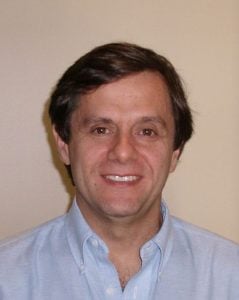Research Professor
Dept. of Computer Science
Johns Hopkins University
Bio from Dept. of Computer Science
Contact
Peter Kazanzides
Johns Hopkins University
Laboratory for Computational Sensing and Robotics
120 Hackerman Hall
3400 North Charles Street
Baltimore, MD 21218
Phone: 410 516 5590
Fax: 410 516 5553
E-mail: pkaz@jhu.edu
Lab webpage: SMARTS Lab
Research Statement
My research activities are in computer-assisted surgery and space telerobotics, which share the common themes of human/machine interfaces to keep the human in the loop, real-time sensing to account for uncertainty, and system engineering to enable deployment in the real world. Surgical robotics requires a partnership between man and machine that must operate in an unstructured environment with constraints on visibility, accessibility, and sterility. My research has focused on the integration of information from various sources, such as preoperative and intraoperative imaging and force sensing, to address these challenges. I have also applied these techniques to space robots; specifically, for a telerobotic system for satellite servicing, which is subject to time delays of 2-7 seconds.
In 1989, while developing a robot for orthopaedic surgery, I pioneered the use of force-controlled guidance as a surgical robot interface. More recently, I have been applying virtual fixtures as guidance and safety constraints and have performed research in augmented reality interfaces for both medical and space applications. My current research interests include the integration of real-time imaging, such as video, ultrasound and photoacoustic imaging, to enable robotic assistance in more challenging environments, such as minimally invasive surgery and microsurgery.
These applications have also motivated me to define and develop enabling systems and architectures. A surgical robot, with associated information sources, generally requires concurrent processing, with low-latency exchange of information. My research involves the application of component-based software engineering concepts to provide a uniform programming model that spans from multi-threaded systems to multi-process and multi-processor systems. This research is embodied in the open-source cisst libraries and Surgical Assistant Workstation (SAW) software. As a service to the research community, I have disseminated the hardware and software to control the da Vinci Research Kit (dVRK) at more than 40 institutions around the world, with additional sites in process.
Education
- Ph.D.in Electrical Engineering, Brown University, May 1988
Thesis: Multiprocessor Control of Robotic Manipulators
Designed and constructed a real-time multiprocessor system (SIERA),which was used for two different robots. Developed and implemented a compliant control strategy which enables a robot to interact with an imprecisely known environment.
- Sc.M. in Applied Mathematics, Brown University, May 1987
- Sc.M. in Electrical Engineering, Brown University, May 1985
Thesis: A Microprocessor-Based Control System with Robotics Applications
Modeled a hydraulic actuator and designed digital control laws. Analyzed the effects of nonlinearities in the model and the control laws and presented experimental results to verify the theory.
- Sc.B. in Electrical Engineering and A.B in Computer Science, Brown University, May 1983
Professional Experience
- Research Professor, Dept. of Computer Science, Johns Hopkins Univ., Baltimore, MD (2014 – present)
- Associate Research Professor, Dept. of Computer Science, Johns Hopkins Univ. (2008-2014)
- Assistant Research Professor, Dept. of Computer Science, Johns Hopkins Univ. (2002-2008)
- Co-founder and Director of Robotics and Software, Integrated Surgical Systems, Davis, CA (November 1990 – June 2002)
Formed ISS to develop and commercialize the ROBODOC® System for orthopedic surgery. Designed and implemented the electronics and software, achieving major improvements in the user interface, safety systems, accuracy (calibration), maintainability and cost. Worked with robot manufacturer to customize industrial robot for medical use. Participated in ISO9001 certification and CE marking, including EMC certification for emissions and immunity. Obtained 510(K) clearance from FDA for ORTHODOC planning system. Program Manager for $4 million NIST ATP joint venture (ISS, IBM and Johns Hopkins University) investigating the application of robotics to total hip revision surgery. Extensive involvement with customers, including system installation, training of personnel, support during surgical procedures, system maintenance, trade show demonstrations and marketing support.
- Visiting Associate Research Engineer, Univ. of California, Davis, CA (March 1990 – November 1990
Continued work on hip replacement robot that was started as joint project between IBM and U.C. Davis. Brought robot into veterinary operating room, where it was used for 26 canine surgeries, all successful.
